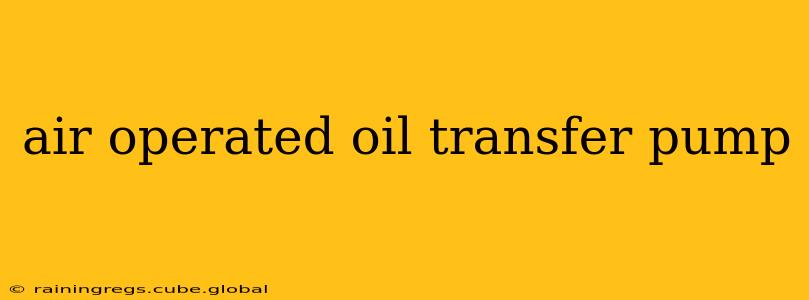Air operated oil transfer pumps are indispensable tools in various industries, offering a safe and efficient way to move oils and other viscous fluids. Unlike electric pumps, they eliminate the risk of sparks, making them ideal for hazardous environments. This comprehensive guide delves into their functionalities, applications, and key considerations when selecting the right pump for your needs.
What is an Air Operated Oil Transfer Pump?
An air operated oil transfer pump, also known as a pneumatic oil pump, utilizes compressed air to transfer oil and other fluids. This method eliminates the need for an electrical power source, providing inherent safety benefits, especially in flammable or explosive atmospheres. These pumps are robust, reliable, and relatively easy to maintain, making them a preferred choice in many applications. They are commonly used for transferring lubricating oils, hydraulic oils, fuel oils, and other viscous liquids. The pumping action is typically achieved through a diaphragm or piston mechanism driven by compressed air.
How Does an Air Operated Oil Transfer Pump Work?
The operation is quite straightforward. Compressed air is supplied to the pump, powering a diaphragm or piston. This reciprocating motion creates suction, drawing the oil into the pump, and then forces the oil out through the discharge line. The pressure of the compressed air directly controls the pumping speed and flow rate. This simple mechanism contributes to the pump's reliability and ease of maintenance.
What are the Advantages of Using an Air Operated Oil Transfer Pump?
Several key advantages make air operated oil transfer pumps a popular choice:
- Safety: The absence of electrical components eliminates the risk of sparks, making them ideal for hazardous environments where flammable liquids are handled.
- Reliability: These pumps are known for their robust construction and ability to withstand harsh conditions. Fewer moving parts contribute to their longevity and reduced maintenance needs.
- Portability: Many air operated oil transfer pumps are relatively lightweight and portable, allowing for easy movement and deployment in various locations.
- Ease of Use: Operation is generally simple and requires minimal training.
- Versatility: They can handle a wide range of viscous fluids, making them adaptable to diverse applications.
- Cost-Effective: While the initial investment might be comparable to electric pumps, the reduced maintenance and increased safety can lead to long-term cost savings.
What are the Different Types of Air Operated Oil Transfer Pumps?
Several types of air operated oil transfer pumps exist, each designed for specific applications and fluid characteristics:
- Diaphragm Pumps: These pumps use a flexible diaphragm to move the fluid. They are well-suited for handling fluids with high viscosity or containing solids.
- Piston Pumps: These pumps employ a piston to displace the fluid. They are generally more efficient for higher-volume applications.
- Rotary Pumps: Although less common for oil transfer, some rotary air-operated pumps exist, offering a different approach to fluid transfer.
The choice between these types depends on factors like flow rate, viscosity of the fluid, and the presence of any solids or contaminants.
What are the Applications of Air Operated Oil Transfer Pumps?
Air operated oil transfer pumps find applications across diverse industries:
- Automotive Industry: Transferring engine oil, lubricants, and other fluids.
- Industrial Manufacturing: Moving hydraulic fluids, lubricating oils, and coolants.
- Chemical Processing: Transferring various chemicals and viscous fluids.
- Marine and Offshore: Handling fuel oil and lubricants in potentially hazardous environments.
- Construction: Transferring lubricating oils for heavy machinery.
How to Choose the Right Air Operated Oil Transfer Pump?
Selecting the appropriate air operated oil transfer pump involves considering several factors:
- Flow Rate: The volume of fluid to be transferred per unit time.
- Viscosity: The thickness of the fluid.
- Pressure: The required pressure to overcome system resistance.
- Fluid Compatibility: Ensuring the pump materials are compatible with the fluid being transferred.
- Safety Requirements: The presence of flammable or explosive atmospheres.
- Portability: The need for a portable or stationary pump.
What are the Maintenance Requirements for Air Operated Oil Transfer Pumps?
Regular maintenance is crucial for optimal performance and longevity:
- Lubrication: Regular lubrication of moving parts is essential.
- Air Filter Maintenance: Clean or replace air filters regularly to prevent contamination.
- Visual Inspection: Regularly inspect for leaks, wear, and tear.
- Diaphragm/Piston Replacement: Periodic replacement of these components as needed.
What Safety Precautions Should Be Taken When Using an Air Operated Oil Transfer Pump?
Safety is paramount when handling oil and operating any pump:
- Use appropriate personal protective equipment (PPE).
- Ensure proper ventilation.
- Follow the manufacturer's instructions carefully.
- Inspect the pump and hoses for damage before each use.
- Never operate the pump near open flames or ignition sources.
This guide provides a comprehensive overview of air operated oil transfer pumps. Remember to always consult the manufacturer's specifications and safety guidelines before using any pump. Selecting the right pump for your specific application is crucial for ensuring efficiency, safety, and longevity.
